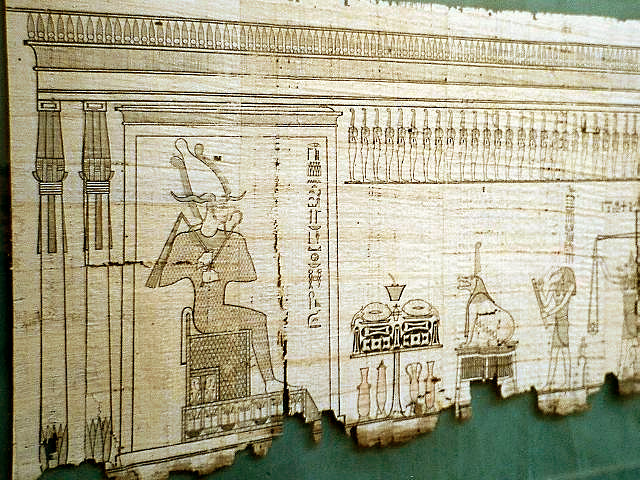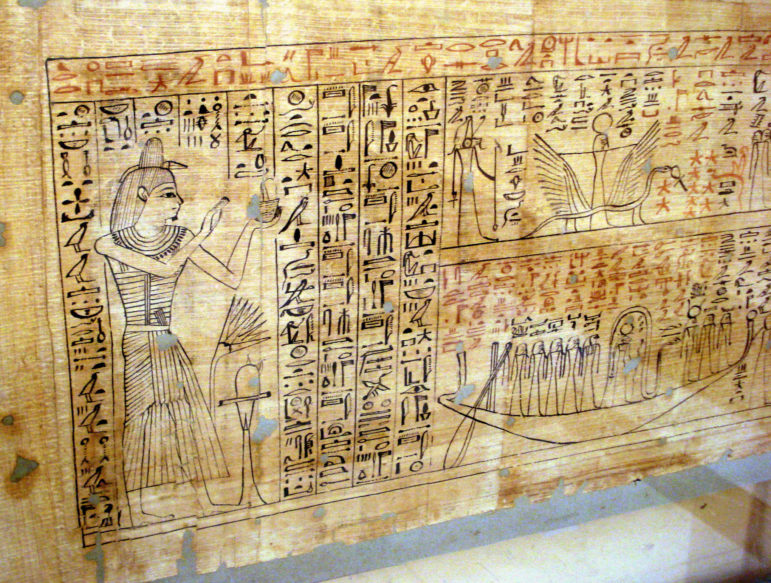TWH – Archaeologists have begun to revise their beliefs about Egyptian funerary texts in the Ptolemaic and Roman eras.
The Archaeology News Network reported that archaeologist, Foy Scalf, re-analyzed the “The First Book of Breathing,” a funerary texts from that time period. Scalf argued, “the so-called Books of Breathing have been central to this ongoing discussion.”

Papyri depicting the Osiris and the weighing of the heart – Image credit: Egypt.Papyrus.01.jpg: Hajor JMCC1 CC BY-SA 3.0
The ancient text contained guides for the newly deceased on their journey in the afterlife. In that narrative, the deceased would become divine and present themselves to the community of gods.
Scalf argues that ancient scribes extracted spells from the older, but loosely-organized, “Book of the Dead.” They interwove those already ancient spells with new material and commentary and reworked some passages.
In contemporary terms, the scribes “updated” the ancient “The Egyptian Book of the Dead” in creating “The First Book of Breathing.” Scalf argues that “The First Book of Breathing” played a critical role in the dynamism of Egyptian religion in the Ptolemaic and Roman eras.
The term “book” is somewhat of an anachronism. To modern ears, the word “book” conjures up images of a mass-produced object, which consists of bound pages of paper. In each mass-produced book, the text on any given page will be identical to the text on the same page in all other copies.
In ancient Egypt, scribes inked hieroglyphics on scrolls of papyrus. Rather than a set of individual pages, a papyrus is one continuous sheet, forming a scroll.
They also decorated walls of tombs and certain objects with hieroglyphics. Somewhat like emojis, hieroglyphics are images in themselves. Papyri were not mass-produced commodities. Definitive versions of papyri may not exist. As copying would be labor-intensive, few copies would exist.
Evidence suggests that a single scribe wrote “The First Book of Breathing” on the Nile’s west bank, near Thebes. Based on analysis of the writing, archaeologists believe that the single scribe produced this scroll sometime between roughly 50 B.C.E. and roughly 125 C.E.
The content of “The First Book of Breathing”
A row of illustrations runs along the top portion of the papyrus. Those illustrations include a cow deity on a shrine, a judgment scene, and three protective genii. One human-headed figure holds a knife, a crocodile-headed figure, a mace, and a jackal-headed figure holds a knife.
At the funeral, priests would place “The First Book of Breathing” under the head of the deceased, and place “The Second Book of Breathing” under their feet. The placement of the scrolls would have been to allow the deceased to utilize the books as guides to the afterlife.
“The Book of the Dead Papyrus of Irtyuru”
In May, Scalf organized an exhibit of the Milbank Papyrus, “The Book of the Dead Papyrus of Irtyuru.” Available online, this website also contains Scalf’s translations and commentaries.

Papyri on display at the Egyptian Museum – Image credit: Egyptian_Museum_17.JPG: Kristoferb CC BY-SA 3.0
The Milbank papyrus predates “The First Book of Breathing,” and dates from the second century B.C.E. Similar to the “The First Book of Breathing,” the Milbank papyrus has a row of illustrations running across the top of the scroll. The texts consist of a series of spells. The scribes wrote the narrative aspects of the spells in black ink and commented on the narrative in red ink.
The Milbank papyrus organizes the spells into a narrative of the journey of the deceased’s soul. The spells drive the journey. It begins with spells for the funeral of Irtyuru, the deceased. As one enacts the spells, the soul moves through the afterlife. Some spells provide protection. Others call forth a favorable judgment from Osiris in the weighing of the heart. Eventually, the soul approaches the community of the gods.
Incan offerings of llamas
TAMBO VIEJO, Peru – Live Science reported on continuing excavations at Tambo Viejo near the Peruvian coast. Archaeologists found evidence of sacrificed llamas in that location. They dated the sacrifice to roughly 1500 C.E.
In Tambo Viejo, two buildings surround a central plaza. Archaeologists found llama remains buried under the clay floors in each building.
In one building, they found four llamas. One had brown fur, and the other three llamas had white fur. In the other building, they found the remains of one brown llama buried beneath the clay floor. The Incas offered brown llamas to the creator god, Viracocha, and the white llamas to the sun god.
Prior to the offerings, the Incas had decorated the white llamas with designs in red paint. The Incas had buried all the llamas facing to the east. They dyed tassels red, yellow, green, or purple. Then, they tied those tassels to the ears of the llamas. The Incas also placed colored strings around the necks of the llamas.
They buried one white llama with a guinea pig. They buried all three white llamas near pits filled with maize cobs, lima beans, and guinea pigs. Those pits also contained a type of lime ash, involved in chewing coca leaves. The Inca considered the coca plant sacred. Modern people use it to make cocaine.
Before sacrifice, the Incas folded the llama’s legs under each llama. Then, they tied those legs in that position. Archaeologists theorize that the Incas buried the llamas alive.
The Wild Hunt has previously reported on the offering of guinea pigs found at this site.
Göbekli Tepe may have a neighbor
KAHIN TEPE, Turkey – Archaeology New Networks reported on an excavation Kahin Tepe, which archaeologists are calling it the oldest site ever excavated in the Black Sea Region. The site dates to a period without ceramics, which lasted between 12,000 and 7,000 B.C.E.
The Kastamonu Museum Directorate and archaeologist, Nurperi Ayengin, are leading this excavation. Ayengin noted stylistic similarities between this site and Göbekli Tepe.
Ayengin said, ”We think that this is a sacred area where people came at certain times of the year to hunt, share their knowledge, worship, and make statues of animals.”
The Wild Hunt is not responsible for links to external content.
To join a conversation on this post:
Visit our The Wild Hunt subreddit! Point your favorite browser to https://www.reddit.com/r/The_Wild_Hunt_News/, then click “JOIN”. Make sure to click the bell, too, to be notified of new articles posted to our subreddit.